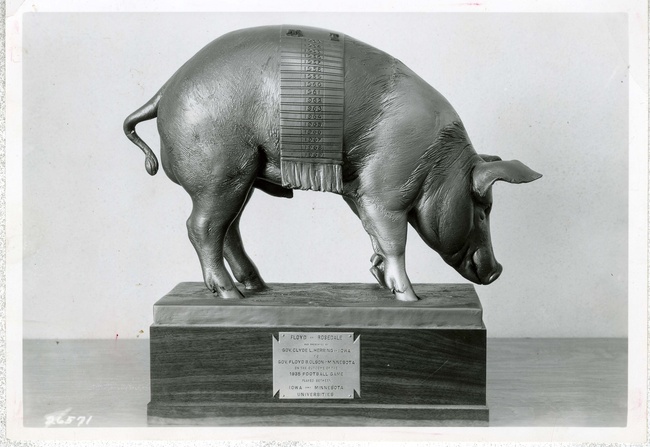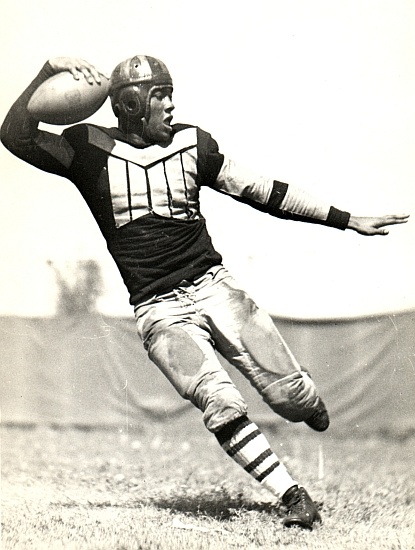Floyd of Rosedale: College Football, Racism, and American History
Lesson Abstract
The Floyd of Rosedale trophy is played for annually between the University of Minnesota and the University of Iowa football teams. The Floyd of Rosedale trophy is most of all about football, a celebrated college rivalry, but look a little deeper and it's also about American history. It began in an era when racial discrimination was widespread, and protected at the highest levels of government. This lesson looks at the history of the trophy and the attitudes about race that helped create the need for the trophy in the first place.

Learning Goals
Students will explore the history of the trophy with photographs and stories. Students will also consider what it was like to be an African American football player during a time of widespread racism, even at institutions of higher learning. Students will also consider inter-state rivalries, state economies, gambling governors, farming and agriculture, and the ongoing importance of the Floyd of Rosedale.
Background
The following text is taken from Wikipedia:
The 1934 game between the Hawkeyes and Golden Gophers had been filled with controversy over the treatment of Iowa star halfback Ozzie Simmons. Simmons was also one of the few black football players of that era, and several rough hits by the Gophers on Simmons forced him to leave the game multiple times in Minnesota’s 48–12 victory. “What it amounted to was that they were piling on – late hits,” Simmons recalled. “I had bruised ribs...they came at me with knees high, and some of it was pretty obvious.”

The following year, Coach Bernie Bierman’s Gophers were 5–0, and Coach Ossie Solem’s Hawkeyes were 4–0–1. Before the 1935 Iowa–Minnesota contest in Iowa City, Bierman received a flood of threatening letters from Iowa fans. He requested and received special police protection for the team when it detrained in Iowa a couple days before the contest.
To lighten the mood, Minnesota Governor Floyd Olson sent a telegram to Governor Herring on game-day morning, which read, "Dear Clyde, Minnesota folks excited over your statement about the Iowa crowd lynching the Minnesota football team. I have assured them that you are a law-abiding gentleman and are only trying to get our goat. The Minnesota team will tackle clean, but, oh! how hard, Clyde. If you seriously think Iowa has any chance to win, I will bet you a Minnesota prize hog against an Iowa prize hog that Minnesota wins today. The loser must deliver the hog in person to the winner. Accept my bet thru a reporter. You are getting odds because Minnesota raises better hogs than Iowa. My best personal regards and condolences."
The Iowa governor accepted, and word of the bet reached Iowa City as the crowd gathered at the stadium. Things calmed down and the game was untroubled. Minnesota won 13–6, and Iowa star Ozzie Simmons played an injury-free game. Afterwards, the Minnesota players went out of their way to compliment Simmons, and Simmons praised the Gophers for their clean, hard-fought play. Minnesota went on to win their second straight national championship.
Governor Herring obtained an award-winning prize pig which had been donated by Allen Loomis, the owner of Rosedale Farms near Fort Dodge, Iowa. Dubbed Floyd after Minnesota Governor Olson, the pig was the brother of Blue Boy from Will Rogers' movie State Fair. A few days later, Governor Herring collected "Floyd of Rosedale" and personally walked him into Governor Olson’s carpeted office.
Since the two schools could not continue wagering a live pig, Governor Olson commissioned Saint Paul sculptor Charles Brioscho to capture Floyd's image. The result is a 44.5 kg (98 lb) bronze pig trophy, 53 cm (21 in) long and 38 cm (15 in) high.[7] Iowa and Minnesota have played for the Floyd of Rosedale every year since then. The winner of the annual Iowa–Minnesota football game is entitled to keep the trophy until the following year's contest.
Questions
- Why would Ozzie Simmons play in football games when he knew he would be injured?
- What would it be like to be the only black player during a time of widespread racism?
- Why did the bet between the two governors help relieve tensions?
- Why did the governor of Minnesota bet a prized hog?
- Should Minnesota and Iowa keep playing for a live hog? What would be the benefits or problems with this?
Documents
http://en.wikipedia.org/wiki/Iowa%E2%80%93Minnesota_football_rivalry
http://news.minnesota.publicradio.org/features/2005/11/14_steilm_floydofrosedale/